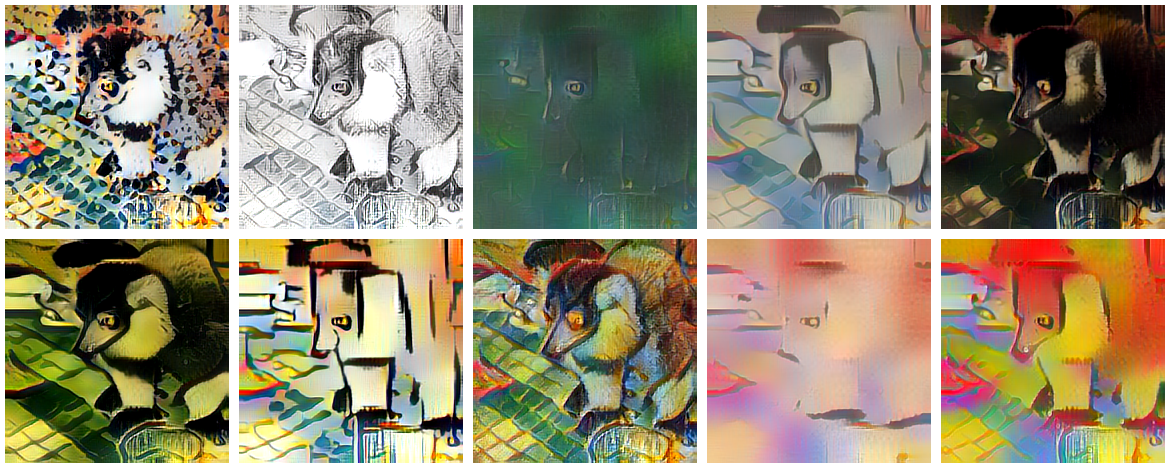This repository contains information and code on how to create Stylized-ImageNet, a stylized version of ImageNet that can be used to induce a shape bias in CNNs as reported in our paper ImageNet-trained CNNs are biased towards texture; increasing shape bias improves accuracy and robustness by Robert Geirhos, Patricia Rubisch, Claudio Michaelis, Matthias Bethge, Felix A. Wichmann, and Wieland Brendel. We hope that you may find this repository a useful resource for your own research. Note that all code, data and materials concerning this paper are available in a separate repository, namely rgeirhos:texture-vs-shape.
Please don't hesitate to contact me at robert.geirhos@bethgelab.org or open an issue in case there is any question!
Here are a few examples of how different stylizations of the same ImageNet image can look like:
 As you can see, local textures are heavily distorted, while global object shapes remain (more or less) intact during stylization. This makes Stylized-ImageNet an effective dataset to nudge CNNs towards learning more about shapes, and less about local textures.
As you can see, local textures are heavily distorted, while global object shapes remain (more or less) intact during stylization. This makes Stylized-ImageNet an effective dataset to nudge CNNs towards learning more about shapes, and less about local textures.
- Get style images (paintings). Download
train.zipfrom Kaggle's painter-by-numbers dataset; extract the content (paintings) into this new directory:code/paintings_raw/(about 38G). - Get ImageNet images & set path. If you already have the ImageNet images, set the
IMAGENET_PATHvariable incode/general.pyaccordingly. If not, obtain the ImageNet images from the ImageNet website and store them somewhere locally, then set the variable. Note that the ImageNet images need to be split in two subdirectories,train/andval/(for training and validation images, respectively). In any case, also set theSTYLIZED_IMAGENET_PATHvariable (also incode/general.py). This variable indicates the path where you would like to store the final dataset. Make sure you have enough disk space: In our setting, Stylized-ImageNet needs 134G of disk space (which is a bit less than standard ImageNet with 181G). - go to
code/and executecreate_stylized_imagenet.sh(assuming access to a GPU). The easiest way for doing this is to the docker image that we provide (see Section below). This creates Stylized-ImageNet in the directory that you specified in step 2. - Optionally, delete
paintings_raw/,paintings_excluded/andpaintings_preprocessed/which are no longer needed.
We provide a docker image so that you don't have to install all of the libraries yourself here: https://hub.docker.com/r/bethgelab/deeplearning/. The repo is tested with bethgelab/deeplearning:cuda9.0-cudnn7.
We provide CNNs that are trained on Stylized-ImageNet at rgeirhos:texture-vs-shape.
ImageNet images are typically normalized using the standard ImageNet mean and std parameters when training a model. Stylized-ImageNet can be used as a drop-in replacement for ImageNet during training, i.e. the results in our paper are based on identical normalization as for ImageNet images. More specifically, we use ImageNet mean and std for both datasets when training; with mean and std parameters taken from the PyTorch ImageNet example training script.
The code itself heavily relies on the pytorch-AdaIN github repository by Naoto Inoue (naoto0804), which is a PyTorch implementation of the AdaIN style transfer approach by X. Huang and S. Belongie, "Arbitrary Style Transfer in Real-time with Adaptive Instance Normalization", published at ICCV 2017. In fact, the entire AdaIN implementation is taken from this repository; in order to enable anyone to create Stylized-ImageNet with as little additional effort as possible we here make everything available in one repository (preprocessing, style transfer, etc.).
If you find Stylized-ImageNet useful for your work, please consider citing it:
@inproceedings{
geirhos2018,
title={ImageNet-trained {CNN}s are biased towards texture; increasing shape bias improves accuracy and robustness.},
author={Robert Geirhos and Patricia Rubisch and Claudio Michaelis and Matthias Bethge and Felix A Wichmann and Wieland Brendel},
booktitle={International Conference on Learning Representations},
year={2019},
url={https://openreview.net/forum?id=Bygh9j09KX},
}